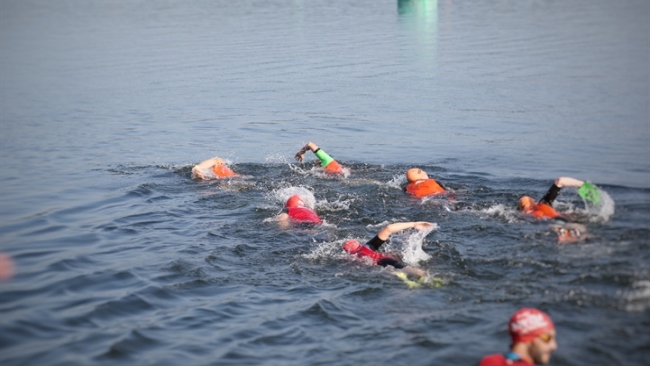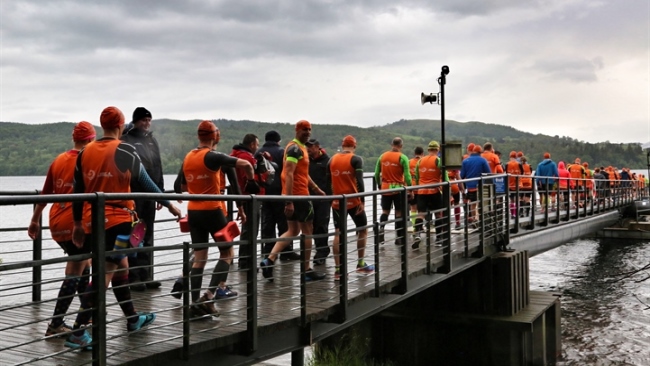In 2019, Simon Griffiths and his partner won the middle distance event at Great North SwimRun. Here, he talks through his preparations and passes on some of his top tips for you to succeed on the day
One of my favourite ever swims was the first leg of the 2018 Great North Swimrun. Windermere was smooth as glass, the surrounding mountains perfectly mirrored in the water. A trace of morning mist drifted around the lake shore. Despite swimming in running shoes, the 1.1km crossing of the lake felt effortless. The water was a comfortable 19 degrees.
However, although I was fit for swimming that year, I hadn’t done nearly enough run training. It was a hot day and the trails were steep. After about 15km, my legs decided they’d had enough, and I had to walk – or hobble, rather – to the finish. Luckily the final section was a swim!
Contrast that to 2019. Windermere was so rough the organiser cancelled the first swim and ferried us across the lake to Wray Castle, where we started with a 5km run in the rain. The only swims we could do were in the more sheltered parts of the lake close to the shore. Even there, the conditions were rough and the water bone-numbingly cold in a shortie swimrun wetsuit. The trails were wet and slippery. Nevertheless, the Lake District was as beautiful as ever and I had done the necessary run training, having learned the hard way how painful it can be if you don’t.
The same race, one year apart, and two totally different experiences. Who knows what 2020 will bring? But that is part of the attraction of swimrun. You never know exactly what to expect. So how do you prepare for it?

Understand Your Event
What are the total distances and how are those broken up? How far is the longest swim and the longest run? What is the proportion of swimming to running? What type of water will you be swimming in? What type of surfaces will you have to run on?
At the Great North SwimRun there are three distances to choose from: short, middle and endurance. My favourite is the middle because it includes (weather permitting) the beautiful crossing of the lake and has a higher proportion of swimming (14%) than the endurance (10.5%). However, the endurance looks tempting if you’re a strong runner, with nearly 35km of trails including some tough climbs and descents.
Do The Training
Essentially, swim and run, a lot. Run off road as much as you can and up and down all hills you can find. Your legs will thank you for it (well, maybe not while you’re doing the training, but they will on event day). The Great North SwimRun is early in the season, so you may find it difficult to fit in lots of specific swimrun training, but do it if you can. The repeated transitions from swimming to running and back again take some getting used to.
Practise in the kit you’re going to use on the day so you can find out in advance (and therefore take preventative action) if anything is going to be uncomfortable or chafe. Don’t avoid training in bad weather, unless it’s dangerous. You don’t know what you will get on the day. It doesn’t matter if your shoes get wet. You need to get used to that anyway.

Remember to increase your training gradually and systematically, and stretch, roll and do mobility exercises to keep yourself injury free.
Make a plan for the event that includes a detailed timetable of where you need to be and when, a full kit list and what you’re going to eat and drink before and during the race. You might be staying in a place that doesn’t offer early breakfast, so make sure you know what you will do instead. Also, discuss and agree your race strategy with your race partner!
Cut back on your training in the week leading up to the event and get some extra rest and sleep instead. You need to arrive in Windermere the day before the race for the compulsory briefing and kit check. Make sure you attend and listen to the safety advice and additional information about the course and conditions, and take note of the location of feed stations. On race day, arrive and change in good time. It’s worth having options such as arm warmers, calf guards and an extra cap in case it’s colder than you expected. And bring something warm and waterproof to put on while waiting for the start. Listen out for any last-minute changes to the route (it happens).
Don't Peak Too Soon
Finally, remember that the Great North SwimRuns, even the short distance, are endurance events, so don’t start off like you’re in a 100m sprint. While the first run is deceptively easy as it’s mostly flat along the lake shore, don’t get carried away. Save something for the climbs that come later. But if you do blow up and have to walk, so be it. Don’t berate yourself or your fitness. Be grateful that you’re out and about in some of the UK’s most spectacular countryside. Breathe the air deeply and enjoy the experience.
Simon Griffiths is the founder and publisher of Outdoor Swimmer magazine, which now includes a dedicated section on swimrun. In 2019, he and his race partner won the middle distance event at the Great North Swimrun.
Sign up to our newsletter
Be the first to find out about Great Swim events
Sign up now